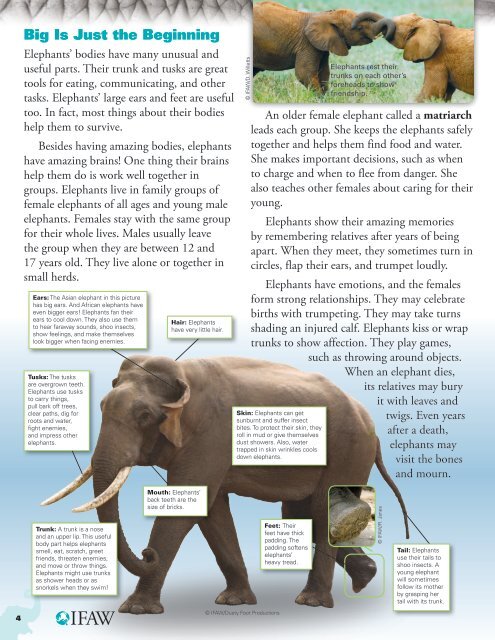Elephants Never Forget Teaching Guide and - Time for Kids
Elephants Never Forget Teaching Guide and - Time for Kids
Elephants Never Forget Teaching Guide and - Time for Kids
You also want an ePaper? Increase the reach of your titles
YUMPU automatically turns print PDFs into web optimized ePapers that Google loves.
Big Is Just the Beginning<br />
<strong>Elephants</strong>’ bodies have many unusual <strong>and</strong><br />
useful parts. Their trunk <strong>and</strong> tusks are great<br />
tools <strong>for</strong> eating, communicating, <strong>and</strong> other<br />
tasks. <strong>Elephants</strong>’ large ears <strong>and</strong> feet are useful<br />
too. In fact, most things about their bodies<br />
help them to survive.<br />
Besides having amazing bodies, elephants<br />
have amazing brains! One thing their brains<br />
help them do is work well together in<br />
groups. <strong>Elephants</strong> live in family groups of<br />
female elephants of all ages <strong>and</strong> young male<br />
elephants. Females stay with the same group<br />
<strong>for</strong> their whole lives. Males usually leave<br />
the group when they are between 12 <strong>and</strong><br />
17 years old. They live alone or together in<br />
small herds.<br />
Ears: The Asian elephant in this picture<br />
has big ears. And African elephants have<br />
even bigger ears! <strong>Elephants</strong> fan their<br />
ears to cool down. They also use them<br />
to hear faraway sounds, shoo insects,<br />
show feelings, <strong>and</strong> make themselves<br />
look bigger when facing enemies.<br />
Tusks: The tusks<br />
are overgrown teeth.<br />
<strong>Elephants</strong> use tusks<br />
to carry things,<br />
pull bark off trees,<br />
clear paths, dig <strong>for</strong><br />
roots <strong>and</strong> water,<br />
fight enemies,<br />
<strong>and</strong> impress other<br />
elephants.<br />
Hair: <strong>Elephants</strong><br />
have very little hair.<br />
© IFAW/D. Willetts<br />
<strong>Elephants</strong> rest their<br />
trunks on each other’s<br />
<strong>for</strong>eheads to show<br />
friendship.<br />
An older female elephant called a matriarch<br />
leads each group. She keeps the elephants safely<br />
together <strong>and</strong> helps them find food <strong>and</strong> water.<br />
She makes important decisions, such as when<br />
to charge <strong>and</strong> when to flee from danger. She<br />
also teaches other females about caring <strong>for</strong> their<br />
young.<br />
<strong>Elephants</strong> show their amazing memories<br />
by remembering relatives after years of being<br />
apart. When they meet, they sometimes turn in<br />
circles, flap their ears, <strong>and</strong> trumpet loudly.<br />
<strong>Elephants</strong> have emotions, <strong>and</strong> the females<br />
<strong>for</strong>m strong relationships. They may celebrate<br />
births with trumpeting. They may take turns<br />
shading an injured calf. <strong>Elephants</strong> kiss or wrap<br />
trunks to show affection. They play games,<br />
such as throwing around objects.<br />
When an elephant dies,<br />
its relatives may bury<br />
it with leaves <strong>and</strong><br />
Skin: <strong>Elephants</strong> can get<br />
sunburnt <strong>and</strong> suffer insect<br />
bites. To protect their skin, they<br />
roll in mud or give themselves<br />
dust showers. Also, water<br />
trapped in skin wrinkles cools<br />
down elephants.<br />
twigs. Even years<br />
after a death,<br />
elephants may<br />
visit the bones<br />
<strong>and</strong> mourn.<br />
Trunk: A trunk is a nose<br />
<strong>and</strong> an upper lip. This useful<br />
body part helps elephants<br />
smell, eat, scratch, greet<br />
friends, threaten enemies,<br />
<strong>and</strong> move or throw things.<br />
<strong>Elephants</strong> might use trunks<br />
as shower heads or as<br />
snorkels when they swim!<br />
Mouth: <strong>Elephants</strong>’<br />
back teeth are the<br />
size of bricks.<br />
Feet: Their<br />
feet have thick<br />
padding. The<br />
padding softens<br />
elephants’<br />
heavy tread.<br />
© IFAW/R. Janes<br />
Tail: <strong>Elephants</strong><br />
use their tails to<br />
shoo insects. A<br />
young elephant<br />
will sometimes<br />
follow its mother<br />
by grasping her<br />
tail with its trunk.<br />
4<br />
© IFAW/Dusty Foot Productions







